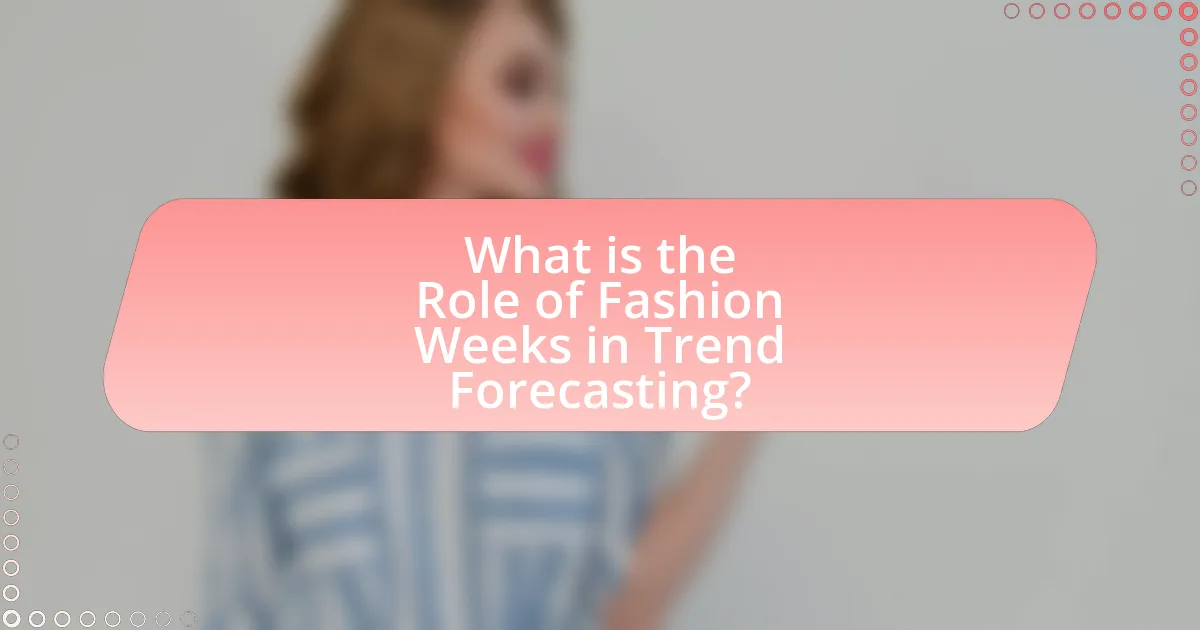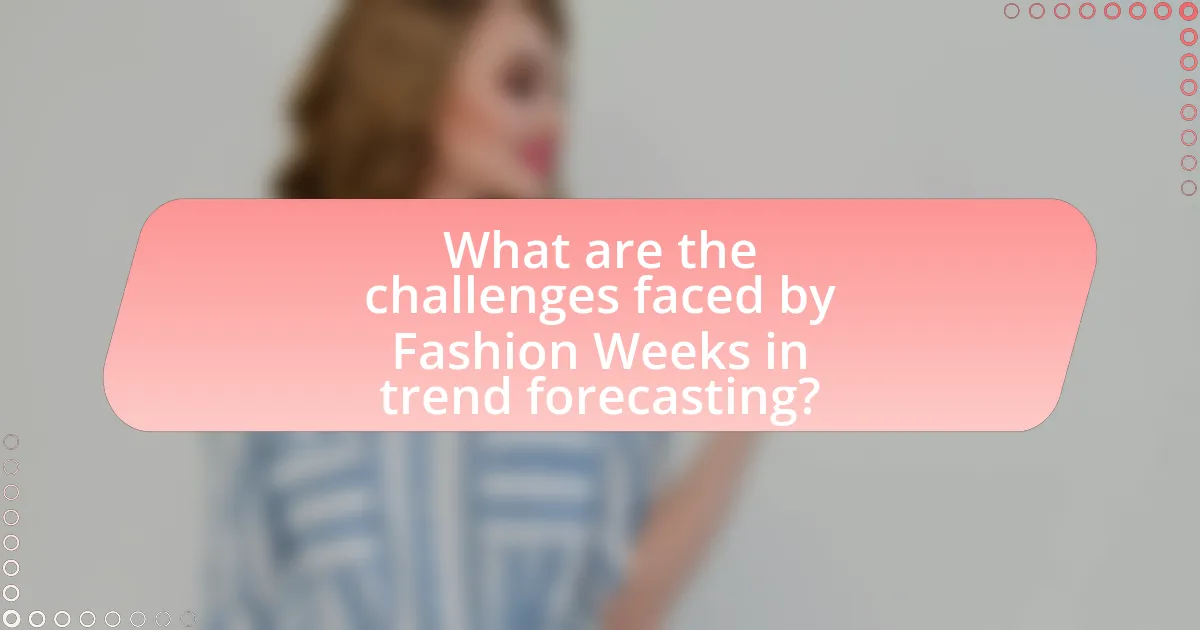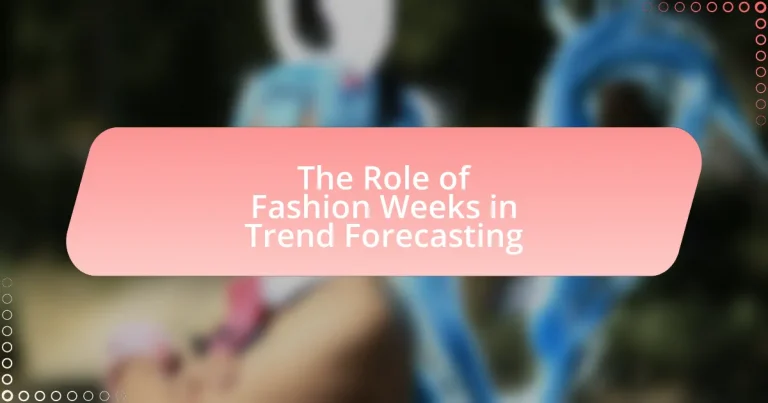Fashion Weeks are pivotal events in the fashion industry that significantly influence trend forecasting by showcasing upcoming styles and designs. These events, held in major cities like New York, Paris, Milan, and London, serve as platforms for designers to present their collections, which are closely analyzed by industry professionals to identify emerging trends. Key activities during Fashion Weeks include runway shows, presentations, and trade shows, all of which impact consumer behavior and purchasing decisions. The article explores how Fashion Weeks set seasonal trends, the challenges faced in trend forecasting, the role of technology and sustainability, and best practices brands can adopt to leverage insights from these events for effective trend forecasting.

What is the Role of Fashion Weeks in Trend Forecasting?
Fashion Weeks play a crucial role in trend forecasting by showcasing upcoming styles and designs that influence the fashion industry for the following seasons. These events serve as platforms for designers to present their collections, which are often analyzed by industry experts, retailers, and media to identify emerging trends. For instance, the Spring/Summer and Fall/Winter Fashion Weeks in major cities like New York, Paris, and Milan set the tone for color palettes, fabrics, and silhouettes that will dominate retail markets. Historical data shows that trends seen on the runway often translate into consumer purchases within six months, highlighting the predictive power of these events in shaping market demand.
How do Fashion Weeks influence the fashion industry?
Fashion Weeks significantly influence the fashion industry by setting trends and establishing the seasonal direction for designers, retailers, and consumers. These events showcase new collections from top designers, which are often interpreted and adopted by various market segments, including fast fashion brands. For instance, the Spring/Summer 2023 Fashion Week in New York highlighted bold colors and oversized silhouettes, which were quickly mirrored in retail offerings, demonstrating the immediate impact of runway trends on consumer choices. Additionally, Fashion Weeks serve as a platform for emerging designers, allowing them to gain visibility and potentially reshape industry standards, further emphasizing their role in trend forecasting.
What are the key events that take place during Fashion Weeks?
Key events during Fashion Weeks include runway shows, presentations, and trade shows. Runway shows feature designers showcasing their latest collections to industry professionals and media, often setting trends for upcoming seasons. Presentations allow designers to display their work in a more intimate setting, often emphasizing craftsmanship and detail. Trade shows facilitate business transactions between designers and retailers, showcasing collections for potential purchase. These events collectively influence fashion trends and consumer preferences, making Fashion Weeks pivotal in the fashion industry.
How do designers showcase their collections at Fashion Weeks?
Designers showcase their collections at Fashion Weeks through runway shows, presentations, and digital formats. Runway shows involve models walking down a catwalk, displaying the latest designs to an audience of industry professionals, influencers, and media, which allows for immediate visual impact and trend setting. Presentations may take the form of static displays or interactive experiences, where attendees can view garments up close, often accompanied by a narrative or theme that enhances the collection’s story. Additionally, many designers now utilize digital platforms to reach a broader audience, live-streaming their shows or creating virtual experiences, which has become increasingly important in the context of global accessibility and the rise of online fashion consumption. This multifaceted approach not only highlights the creativity of the designers but also plays a crucial role in influencing upcoming fashion trends, as seen in the significant media coverage and social media engagement that follows these events.
Why are Fashion Weeks important for trend forecasting?
Fashion Weeks are crucial for trend forecasting because they serve as the primary platform where designers showcase their upcoming collections, influencing consumer preferences and industry standards. These events allow fashion professionals, including buyers, journalists, and influencers, to observe and analyze emerging styles, colors, and materials that will dominate the market in the following seasons. Historical data indicates that trends presented during Fashion Weeks often dictate retail offerings, with a significant percentage of styles seen on runways appearing in stores within months. For instance, the Spring/Summer 2020 collections introduced bold colors and oversized silhouettes, which were widely adopted by retailers, demonstrating the direct impact of Fashion Weeks on market trends.
What role do Fashion Weeks play in setting seasonal trends?
Fashion Weeks play a crucial role in setting seasonal trends by showcasing designers’ collections that influence consumer preferences and retail strategies. These events serve as a platform for designers to present their latest creations, which are often adopted by fashion retailers and subsequently impact what consumers purchase. For instance, the Spring/Summer and Fall/Winter Fashion Weeks in major cities like New York, Paris, and Milan are pivotal in determining color palettes, fabrics, and styles for the upcoming seasons, as seen in the widespread adoption of trends like oversized silhouettes and bold colors following their debut on the runway. This cyclical process of presentation and adoption underscores the significance of Fashion Weeks in shaping the fashion landscape.
How do Fashion Weeks impact consumer behavior and purchasing decisions?
Fashion Weeks significantly influence consumer behavior and purchasing decisions by showcasing upcoming trends and styles that shape public perception. These events create a sense of urgency and desirability around new collections, often leading to increased consumer interest and spending. For instance, a study by the Fashion Institute of Technology found that 70% of consumers reported being influenced by runway shows when making purchasing decisions. Additionally, the visibility of high-profile designers and celebrities at these events enhances brand recognition and desirability, further driving consumer engagement and sales.

How do Fashion Weeks contribute to the global fashion landscape?
Fashion Weeks significantly shape the global fashion landscape by serving as pivotal platforms for designers to showcase their collections, influencing trends and consumer preferences worldwide. These events attract industry professionals, media, and influencers, creating a concentrated environment where new styles and ideas are presented, often setting the tone for upcoming seasons. For instance, the New York Fashion Week, held biannually, has historically introduced key trends that later permeate retail markets, demonstrating its impact on consumer behavior and fashion retail strategies. Additionally, according to the Council of Fashion Designers of America, Fashion Weeks generate substantial media coverage, which amplifies the visibility of emerging designers and trends, further solidifying their role in global fashion dynamics.
What are the major Fashion Weeks around the world?
The major Fashion Weeks around the world include New York Fashion Week, London Fashion Week, Milan Fashion Week, and Paris Fashion Week. These events are held biannually and showcase the latest collections from top designers, influencing global fashion trends. New York Fashion Week typically occurs in February and September, London Fashion Week follows shortly after, Milan Fashion Week takes place in February and September as well, and Paris Fashion Week concludes the series in March and October. Collectively, these Fashion Weeks are pivotal in setting trends and forecasting the direction of the fashion industry.
How do different cities influence fashion trends through their Fashion Weeks?
Different cities influence fashion trends through their Fashion Weeks by showcasing unique cultural aesthetics and innovative designs that set the tone for global fashion. For instance, Paris Fashion Week is renowned for its haute couture and luxury brands, often dictating high-end trends, while New York Fashion Week emphasizes street style and commercial viability, influencing ready-to-wear collections. Milan Fashion Week is known for its craftsmanship and bold designs, impacting luxury fashion markets, and London Fashion Week often highlights emerging designers and avant-garde styles, pushing boundaries in fashion innovation. These events serve as platforms where designers present their collections, which are then interpreted and adopted by retailers and consumers worldwide, thereby shaping the fashion landscape.
What unique characteristics define each major Fashion Week?
New York Fashion Week is characterized by its commercial focus and diverse range of designers, showcasing both established and emerging talent. Paris Fashion Week is known for its haute couture and luxury brands, emphasizing artistry and craftsmanship. Milan Fashion Week stands out for its emphasis on Italian craftsmanship and luxury, featuring iconic fashion houses. London Fashion Week is recognized for its avant-garde and innovative designs, often highlighting emerging designers and street style influences. Each Fashion Week plays a crucial role in setting trends and influencing the global fashion landscape, reflecting the cultural and economic contexts of their respective cities.
How do Fashion Weeks interact with social media and digital platforms?
Fashion Weeks interact with social media and digital platforms by leveraging these channels to amplify their reach and engage with a global audience. Designers and brands utilize platforms like Instagram, Twitter, and TikTok to showcase collections in real-time, allowing immediate feedback and interaction from viewers. For instance, during New York Fashion Week 2021, over 1.5 million posts were shared on Instagram, highlighting the event’s significant online presence. This interaction not only enhances visibility but also influences consumer behavior and trend forecasting, as social media analytics provide insights into audience preferences and emerging trends.
What is the impact of social media on trend visibility during Fashion Weeks?
Social media significantly enhances trend visibility during Fashion Weeks by providing real-time access to collections, street style, and influencer commentary. This immediate dissemination allows brands and designers to reach a global audience instantly, amplifying their visibility beyond traditional media coverage. For instance, according to a study by the Business of Fashion, 70% of consumers reported that social media influenced their fashion choices, highlighting its role in shaping trends. Additionally, platforms like Instagram and TikTok enable users to share and engage with content, creating viral moments that can elevate specific styles or designers overnight. This interconnectedness between social media and Fashion Weeks has transformed how trends are forecasted and adopted in the fashion industry.
How do influencers and celebrities shape trends during Fashion Weeks?
Influencers and celebrities shape trends during Fashion Weeks by leveraging their visibility and social media platforms to amplify designer collections and styles. Their attendance at these events often garners significant media coverage, which in turn influences public perception and consumer behavior. For instance, when high-profile figures wear specific designs or accessories, it can lead to increased demand and sales for those items, as evidenced by the phenomenon known as the “celebrity effect.” This effect is supported by research indicating that 70% of consumers are influenced by celebrity endorsements in their purchasing decisions. Additionally, influencers often curate content that highlights emerging trends, making them accessible to a broader audience and accelerating the adoption of new styles.

What are the challenges faced by Fashion Weeks in trend forecasting?
Fashion Weeks face several challenges in trend forecasting, primarily due to the rapid pace of change in consumer preferences and the influence of social media. The fashion industry is increasingly driven by immediate feedback from digital platforms, making it difficult for designers to predict long-term trends accurately. Additionally, the globalization of fashion means that trends can emerge simultaneously in different markets, complicating the forecasting process. According to a report by McKinsey & Company, 75% of fashion executives believe that the speed of change in consumer behavior is a significant challenge for trend forecasting. This rapid evolution requires Fashion Weeks to adapt quickly, often leading to discrepancies between forecasted trends and actual consumer demand.
How do economic factors affect Fashion Weeks and trend forecasting?
Economic factors significantly influence Fashion Weeks and trend forecasting by shaping consumer spending habits and designer investment decisions. For instance, during economic downturns, luxury brands often reduce their participation in Fashion Weeks, leading to fewer innovative designs and a more conservative approach to trend forecasting. According to a report by McKinsey & Company, the global fashion industry experienced a 93% decline in sales in April 2020 due to the COVID-19 pandemic, which directly impacted the themes and styles presented at Fashion Weeks. Additionally, economic stability encourages designers to experiment with bold trends, as seen in the post-recession period of 2010, where a surge in consumer confidence led to vibrant and daring collections. Thus, economic conditions directly correlate with the vibrancy and direction of trends showcased during Fashion Weeks.
What challenges do designers face in presenting their collections?
Designers face several challenges in presenting their collections, including logistical issues, financial constraints, and the need to effectively communicate their vision. Logistical challenges often involve coordinating schedules, securing venues, and managing the technical aspects of the presentation, which can be complex and time-consuming. Financial constraints can limit the scale and creativity of the presentation, as designers must balance costs with the desire to make a strong impact. Additionally, effectively communicating their artistic vision to an audience that includes buyers, media, and influencers is crucial, as misinterpretation can lead to a lack of interest or support for the collection. These challenges are compounded by the competitive nature of fashion weeks, where numerous designers vie for attention, making it essential for each presentation to stand out.
How do sustainability concerns influence trends showcased at Fashion Weeks?
Sustainability concerns significantly influence trends showcased at Fashion Weeks by driving designers to adopt eco-friendly materials and practices. As consumer awareness of environmental issues rises, brands increasingly prioritize sustainable fashion, leading to the incorporation of organic fabrics, recycled materials, and ethical production methods in their collections. For instance, the 2021 Copenhagen Fashion Week mandated that participating designers adhere to sustainability guidelines, showcasing a shift towards responsible fashion. This trend reflects a broader industry movement, as evidenced by a McKinsey report indicating that 67% of consumers consider sustainability when making fashion purchases. Thus, sustainability not only shapes the aesthetic of collections but also aligns with evolving consumer values, making it a central theme in contemporary fashion presentations.
What innovations are emerging in the context of Fashion Weeks?
Innovations emerging in the context of Fashion Weeks include the integration of digital technology, sustainable practices, and virtual reality experiences. Digital technology has transformed traditional runway shows into hybrid formats, allowing for live streaming and interactive audience engagement, which was notably utilized during the COVID-19 pandemic. Sustainable practices are increasingly prioritized, with brands showcasing eco-friendly materials and ethical production methods, reflecting a growing consumer demand for sustainability in fashion. Additionally, virtual reality experiences are being adopted to create immersive environments for viewers, enhancing the overall experience of Fashion Weeks. These innovations collectively signify a shift towards a more inclusive, sustainable, and technologically advanced fashion industry.
How is technology changing the way Fashion Weeks are conducted?
Technology is transforming Fashion Weeks by integrating digital platforms, virtual reality, and live streaming, which enhance accessibility and engagement. For instance, brands now utilize social media and online streaming to reach global audiences, allowing viewers to experience runway shows in real-time from anywhere. According to a report by McKinsey & Company, the shift to digital formats during the pandemic increased online viewership significantly, with some shows attracting millions of viewers compared to traditional in-person attendance. Additionally, augmented reality is being used to create immersive experiences, enabling consumers to visualize clothing in a virtual environment. This technological evolution not only broadens the audience but also influences trend forecasting by providing immediate feedback and data analytics on consumer preferences.
What role does virtual reality play in the future of Fashion Weeks?
Virtual reality (VR) is set to revolutionize Fashion Weeks by enhancing the immersive experience for attendees and expanding accessibility to global audiences. VR technology allows designers to create virtual runways and showrooms, enabling viewers to experience collections in a 360-degree environment from anywhere in the world. This shift not only democratizes access to high-fashion events but also provides brands with valuable data on consumer engagement and preferences through interactive features. As a result, VR is becoming an essential tool for trend forecasting, allowing designers to gauge real-time reactions and adapt their collections accordingly.
What best practices can brands adopt from Fashion Weeks for trend forecasting?
Brands can adopt several best practices from Fashion Weeks for trend forecasting, including analyzing runway shows, engaging with influencers, and utilizing social media insights. Analyzing runway shows allows brands to identify emerging styles, colors, and materials that designers showcase, which often set the tone for upcoming seasons. Engaging with influencers helps brands gauge consumer sentiment and preferences, as these individuals often reflect and amplify trends. Utilizing social media insights enables brands to track real-time conversations and visual content, providing data on what styles resonate with audiences. These practices are validated by the fact that many successful brands leverage these strategies to stay ahead in the competitive fashion landscape.
How can brands effectively leverage insights from Fashion Weeks?
Brands can effectively leverage insights from Fashion Weeks by analyzing runway trends, consumer reactions, and designer innovations to inform their product development and marketing strategies. By closely monitoring the collections presented, brands can identify emerging styles, colors, and materials that resonate with target audiences. For instance, a study by the Fashion Institute of Technology found that 70% of trends showcased during Fashion Weeks influence retail collections within six months. Additionally, brands can utilize social media analytics to gauge public sentiment and engagement with specific looks, allowing them to tailor their offerings to meet consumer demand. This data-driven approach ensures that brands remain relevant and competitive in the fast-paced fashion industry.
What strategies can brands implement to stay ahead of trends post-Fashion Weeks?
Brands can implement data-driven analysis and consumer engagement strategies to stay ahead of trends post-Fashion Weeks. By leveraging analytics tools, brands can track social media conversations, search trends, and sales data to identify emerging patterns and consumer preferences. For instance, a report from McKinsey & Company highlights that brands using data analytics can predict trends with up to 70% accuracy, allowing them to adapt their collections accordingly. Additionally, engaging directly with consumers through surveys and social media feedback can provide insights into their desires and expectations, enabling brands to innovate and align their offerings with market demands.


